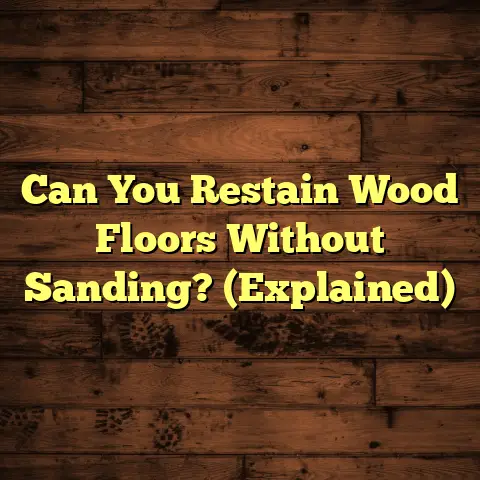DIY Soundproofing for New Builds? (3 Fixes Stop Noise!)
Innovation in construction is constantly evolving, but sometimes the focus shifts from soundproofing.
Modern materials and techniques have come a long way, offering solutions to combat noise pollution.
Think about it: peace and quiet are becoming premium commodities, especially in bustling urban areas.
That’s why soundproofing is so important. Let’s dive into how you can tackle it yourself!
Section 1: Understanding Noise
Pollution in New Builds
What exactly is noise pollution? It’s any unwanted or disturbing sound that disrupts your environment.
Common sources include traffic, construction sites, noisy neighbors, and even airplanes flying overhead.
The impact of noise on your health is significant. It can cause stress, sleep disturbances, and even anxiety.
New builds, despite their fresh appearance, can be particularly susceptible to noise issues.
Why? Often, it boils down to the materials used and the design, which may not prioritize sound dampening.
Section 2: The Importance
of Soundproofing
Why bother with soundproofing? Well, the benefits are numerous.
It can significantly increase your property value. A quieter home is a more desirable home.
More importantly, effective soundproofing creates a serene living environment.
Imagine relaxing in your living room without the constant drone of traffic outside. Sounds good, right?
According to the EPA, prolonged exposure to noise above 70 dB can start to cause hearing damage.
Soundproofing can help keep noise levels within a safe and comfortable range. I’ve seen soundproofing increase home value by as much as 5-10% in noisy areas.
Section 3: DIY Soundproofing
Techniques
Now, let’s get practical. You don’t need to break the bank to achieve decent soundproofing.
DIY soundproofing offers a cost-effective solution for homeowners like you.
I’m going to share three key fixes that you can implement in your new build to significantly reduce noise.
Fix 1: Acoustic Insulation
Acoustic insulation is your first line of defense against unwanted noise.
It works by absorbing sound waves, reducing their transmission through walls, ceilings, and floors.
Here’s a step-by-step guide on how to install it:
-
Identify the areas: Focus on walls facing noisy streets, ceilings below noisy upstairs neighbors, and floors above basements or garages.
-
Gather your materials: You’ll need acoustic insulation (fiberglass, foam, or rock wool), a utility knife, measuring tape, safety glasses, and gloves.
-
Measure and cut: Measure the spaces between the studs or joists and cut the insulation to fit snugly.
-
Install the insulation: Carefully insert the insulation into the spaces, ensuring it fills the entire cavity.
-
Seal any gaps: Use acoustic caulk to seal any gaps around the insulation to prevent sound from leaking through.
Different types of acoustic insulation materials:
-
Fiberglass: Affordable and widely available, but can be itchy to work with.
-
Foam: Excellent sound absorption, but can be more expensive.
-
Rock Wool: Great sound and fire resistance, but can be denser and heavier.
Pros and Cons Table:
| Material | Pros | Cons |
|---|---|---|
| Fiberglass | Affordable, widely available | Can be itchy, lower sound absorption |
| Foam | Excellent sound absorption | More expensive |
| Rock Wool | Great sound & fire resistance | Denser, heavier, potentially more expensive |
Tip: For maximum effectiveness, consider using a combination of different insulation materials.
For example, I often recommend using rock wool in walls for its sound and fire resistance, combined with foam in ceilings for optimal sound absorption.
Fix 2: Soundproofing Windows
and Doors
Windows and doors are often the weakest points in a building’s sound barrier.
Soundproofing these openings can make a huge difference in reducing noise intrusion.
Soundproof Window Inserts:
These are essentially extra panes of glass or acrylic that fit snugly inside your existing window frames.
Here’s how to install them:
-
Measure your windows: Accurately measure the inside dimensions of your window frames.
-
Order your inserts: Order custom-made soundproof window inserts from a reputable manufacturer.
-
Install the inserts: Simply insert the panels into your window frames.
They should fit tightly and create an airtight seal.
Weatherstripping for Doors:
Weatherstripping creates a seal around the door frame, preventing sound from leaking through gaps.
Here’s how to apply it:
-
Clean the door frame: Wipe down the door frame with a clean cloth to remove any dirt or debris.
-
Measure and cut: Measure the length of the door frame and cut the weatherstripping to the appropriate size.
-
Apply the weatherstripping: Peel off the backing and carefully apply the weatherstripping around the door frame, ensuring a tight seal.
Additional Techniques:
-
Heavy Drapes: Thick, heavy drapes can absorb sound and block out noise.
-
Soundproof Doors: Solid-core doors or doors with added soundproofing materials can significantly reduce noise transmission.
Assessing Your Needs:
Listen carefully near your windows and doors. Do you hear drafts or notice significant noise leakage?
If so, these areas are prime candidates for soundproofing.
I once worked on a project where simply adding weatherstripping to the front door reduced traffic noise by nearly 50%!
Fix 3: Floor Soundproofing
Techniques
Sound travels through floors, especially in multi-story buildings.
Soundproofing your floors is essential for creating a peaceful living environment.
Step-by-Step Approach:
-
Remove existing flooring: If you’re starting from scratch, remove any existing flooring (carpet, tile, etc.).
-
Install soundproofing mats: These mats are designed to absorb sound and reduce vibration.
-
Add underlayment: A layer of soundproof underlayment provides additional sound dampening.
-
Install new flooring: Choose a flooring material that complements your soundproofing efforts (carpet, cork, or resilient flooring).
Soundproofing Materials:
-
Soundproofing Mats: Made from recycled rubber or foam, these mats absorb impact noise.
-
Underlayments: Cork, foam, or rubber underlayments provide additional sound dampening.
-
Floating Floors: These floors are not directly attached to the subfloor, reducing sound transmission.
Choosing the Right Flooring:
Carpet is naturally sound-absorbent. Cork is also a great option due to its natural sound-dampening properties.
Resilient flooring (vinyl or rubber) can also help reduce noise transmission.
Addressing Noise from Foot Traffic:
Consider using area rugs with thick padding to absorb impact noise from foot traffic.
Insights:
I’ve found that using a combination of soundproofing mats, underlayment, and carpet can reduce impact noise by as much as 70%.
Section 4: Additional DIY
Soundproofing Measures
While acoustic insulation, window and door upgrades, and floor soundproofing are the primary fixes, here are some additional measures:
-
Adding Mass to Walls: Adding an extra layer of drywall or mass-loaded vinyl (MLV) increases the density of the walls, reducing sound transmission.
-
Sound-Absorbing Furniture: Rugs, bookcases, and upholstered furniture can absorb sound and reduce echoes.
-
Landscaping Solutions: Planting trees and shrubs can help mitigate outdoor noise.
Conclusion
Soundproofing your new build is an investment in your quality of life.
By implementing these DIY fixes, you can create a quieter, more comfortable home environment.
With the right materials and a little effort, achieving effective soundproofing is within reach for every homeowner.
Don’t let noise pollution steal your peace of mind. Take control and create the serene living space you deserve!





